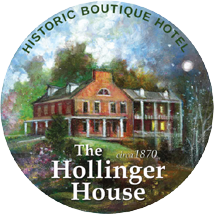The Hollinger family came to America on September 24th, 1737. The family settled in Brickerville, Lancaster County and quickly became entrenched in their community. They donated the very bricks that built the Old Zion Reformed Church, which is considered “probably the best preserved, architecturally, and most important, meeting-house type church surviving in Lancaster County,” according to historian John Snyder. Several Hollingers are buried at the graveyard there.
Johannes Hollinger was the first of the family to take up tanning. In the year 1800, at the age of 12, Johannes became an apprentice to Jacob Kreider on what is now The Hollinger House property. The Kreiders lived in the log cabin that still stands on the property.
Johannes added the brick half of the log house and lived there with his wife. Eventually, Johannes bought the plot of land, measuring 8 acres and 159 perches at the time, for $3,200. After Johannes’ death in 1825 the Tannery passed from his son Johan Jr. to Johan’s brother Cyrus and then to Cyrus’ brother Amos.
Under Amos’ leadership the business expanded greatly and established a national reputation for excellence. Hollinger leather won three medals for their superior quality in Chicago, Philadelphia and even Paris.
Amos was an impressive man who was also instrumental in founding the Reformed Church at Willow Street, was a trustee of Millersville Normal School, President of the Farmer’s Mutual Insurance Co. of Lancaster, President of Conestoga Fire Insurance Company, President of the Tanner’s Insurance Company of Philadelphia, and President of the Lancaster, Willow Street and Strasburg Railroad Company.
He was partly responsible for having the Quarryville Railroad constructed in the 1870s as well as having the trolley line extended from Lancaster to Hollinger and later to Strasburg. He also established a Post Office at what had become the village of Hollinger and formed the Hollinger Telephone Company (later sold to Bell).
Amos was responsible for building the main house in 1870. It was initially meant to be a frame structure, but while under construction a great storm blew it down and it was reconstructed in brick. The third-floor room now called the Ariel room was once used as a classroom for children of tannery workers while the rest of the third-floor rooms were used as bedrooms. The home once housed more than 20 single male tannery workers.
When Amos’ son John entered the partnership, Amos moved to 50 East Orange Street in downtown Lancaster. He conducted business at this address under the name of Amos Hollinger and Son Tanners. He also had an office at 358 North Third Street, Philadelphia.
John Hollinger’s ledger book of 1914-17 listed 600 accounts from as far away as Iowa and Illinois. Though they were having success, John closed the tannery in 1918, as he foresaw the impact the automobile industry would soon have on the demand for their bridles and harnesses.
Around 1927, Mary Hollinger set about modernizing the Hollinger House with architect Henry Y. Shaub. Disillusioned with the “gingerbread” Victorian style of previous generations, Mary was caught up with the Georgian and “Adam-esque” style popular at the time. Mary had the front and north side porches combined and enlarged to wrap around to the side as it does today, and the ornate Victorian carvings were removed.
Two sets of French doors were added to the grand living room. Mary covered the wood grained panels over the doorways with delicate classical plaster motifs. Part of the wall between the front hall and the grand living room was removed and interior columns were added, giving the effect of widening the long, thin room. Mary also had scenic wallpaper from France installed in the living room that sold for $90 a roll at the time. After the Hollinger Post Office closed, Mary saved the glass cubicles used for mail and filled them with china and glass to decorate her breakfast room.
Mary’s passion, aside from her family, was history and antiquing. She was always one for a good bargain and could refinish or glue anything into good order. She was instrumental in many historic preservation efforts in Lancaster County and even convinced downtown merchants to plant trees in front of their buildings in the 1960s, before such efforts were popular. She is to thank for the trees in front of the courthouse and the former Gavin’s store on East King Street in Lancaster.
“MaMa,” as she was called by her grandchildren, was interviewed about the house at Hollinger in March 1985 and was quoted as saying, “I have a theory. If a house is happily lived in for five generations, that happiness seeps into the walls and the woodwork.” We couldn’t agree more. This home has an unmistakable air of joy and love that truly makes it feel like coming home, no matter where you’re from.
Read an extended version of the Hollinger’s history in the house itself by taking a trip to our Lancaster, PA Bed & Breakfast. Click here and here for more information on the rich history of Lancaster County.

